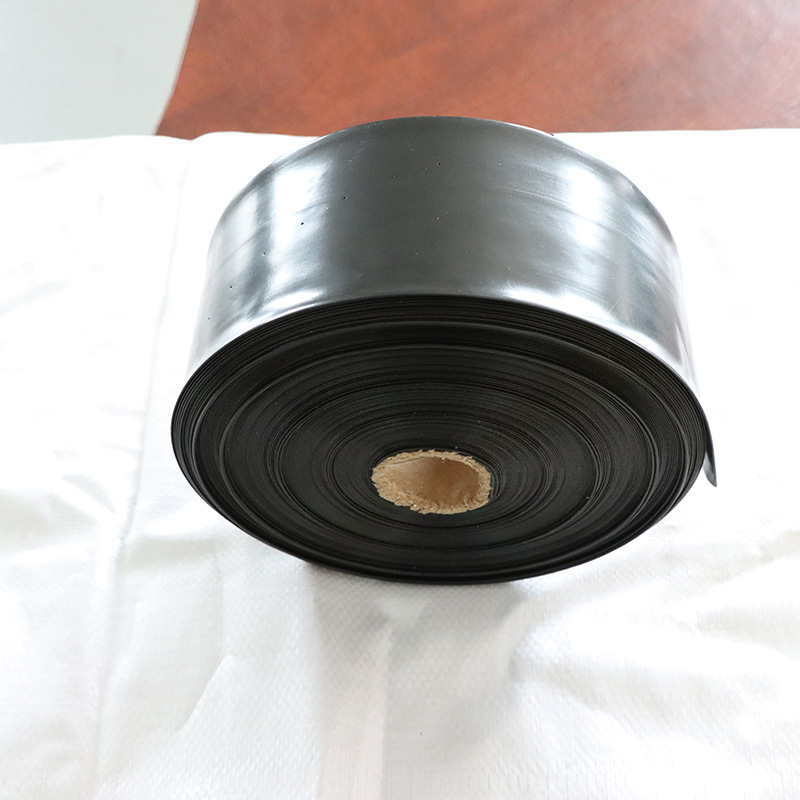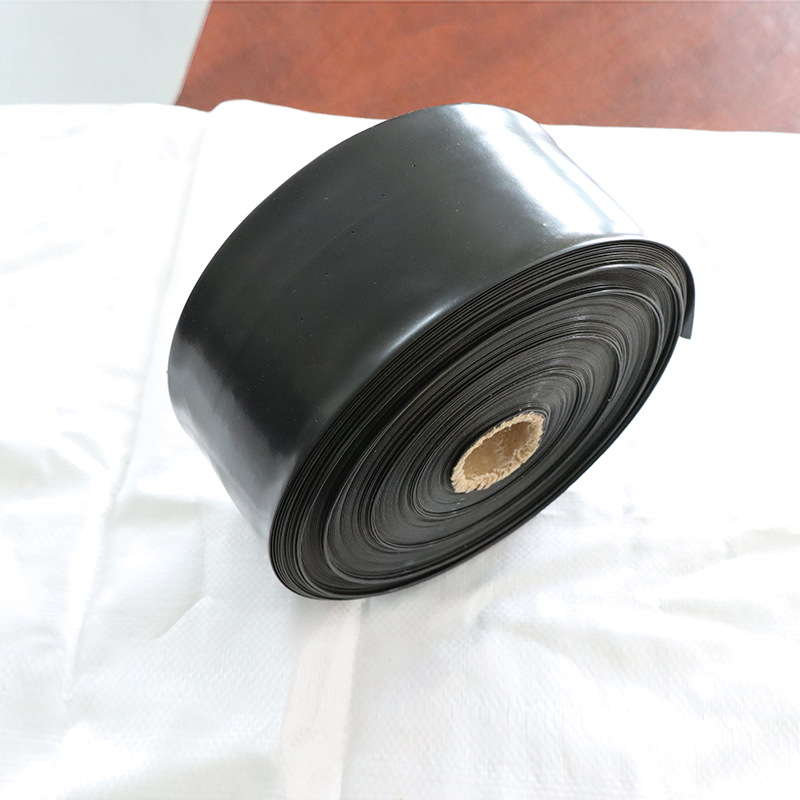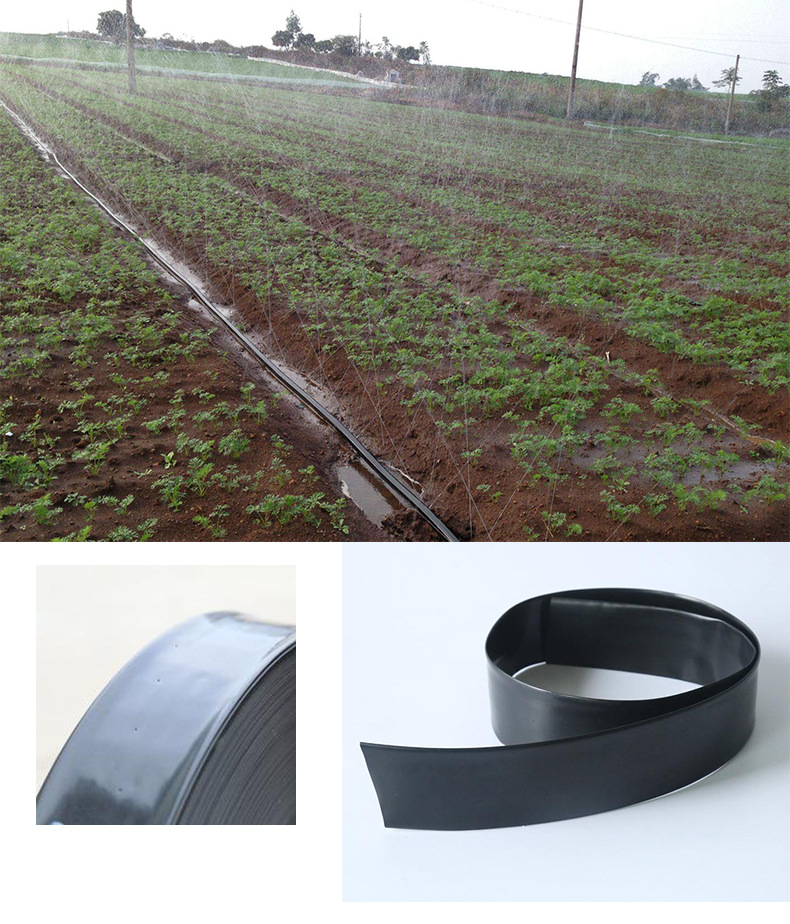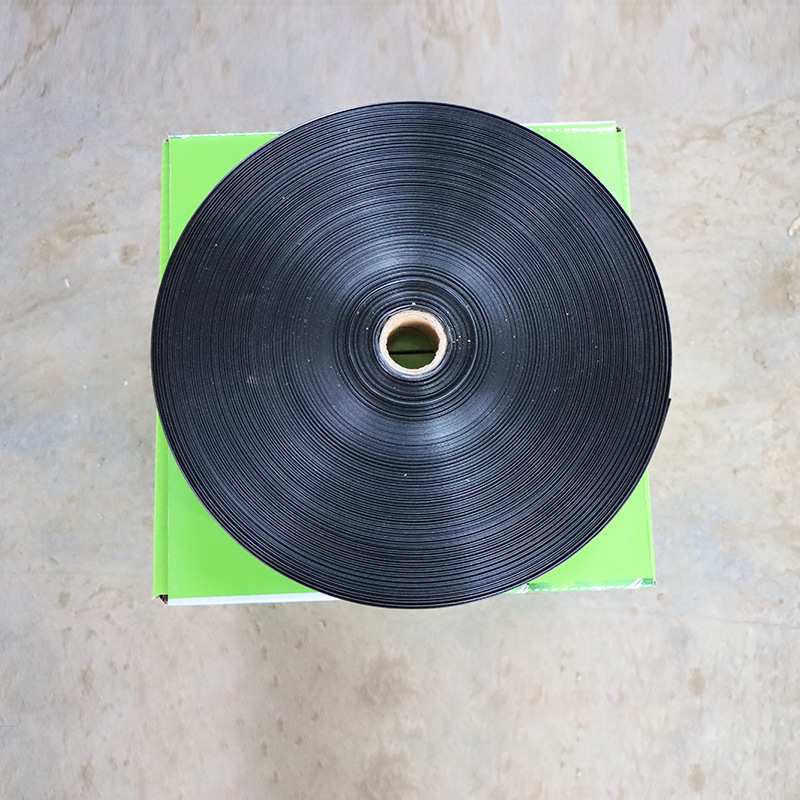What is micro spray irrigation hose?
Micro-sprinkler tape, also known as “sprinkler tape,” “micro-sprinkler tape,” “spray tape,” “spray hose,” “porous hose,” and other names, is a new type of micro-irrigation device. Its working principle involves pressurizing water through a delivery pipe and micro-sprinkler hose to the field. Through the water outlets on the micro-sprinkler tape, under the influence of gravity and air resistance, a fine mist-like spraying effect is created.

Sprinkler tape is a plastic thin-walled hose primarily made from low-density polyethylene, with water outlets directly punched out on one side through mechanical or laser methods. It is also known as porous pipe, spray hose, micro-sprinkler tape, micro-sprinkler irrigation pipe, or micro-irrigation tape. Its main feature is its strong anti-clogging performance and low water source requirements.
When using underground water sources, filtration equipment may not be necessary. It operates at low water pressure, with relatively large flow rates, resulting in shorter irrigation times. Additionally, sprinkler tape requires less material, making it convenient for installation, storage, and transportation. It is currently the most economical option among various irrigation systems.
By laying micro-sprinkler tapes with groups of 3, 5, or more water outlets directly on the ground, the water jets can create a micro-sprinkler irrigation effect similar to fine rain. It is an advanced irrigation technology with several advantages. Firstly, it saves water as micro-sprinkler irrigation minimizes deep seepage and surface runoff, resulting in more uniform water distribution. Typically, water savings range from 30% to 50%. In areas with sandy soils with strong permeability and poor water retention, water savings can reach 70% to 80%.

Characteristics of Micro-Sprinkler Tape
- Maze channels and drip holes are formed by one-time vacuum hot pressing, with good adhesion and high manufacturing precision.
- Multiple outlets with turbulent flow state enhance anti-clogging ability.
- Designed with maze channels, ensuring uniform water distribution, with a coverage rate of over 85% and a laying distance of up to 80 meters.
- Lightweight, easy to install and manage, with low installation costs.
Applicable Conditions
- Suitable for greenhouse and greenhouse crop cultivation, reducing pest and disease incidence, saving fertilizers and pesticides, and improving economic benefits.
- Used for orchard irrigation, effectively increasing yield, improving fruit quality, and controlling weed growth.
- Suitable for a variety of field crops such as cotton, medicinal herbs, watermelon, and field vegetables, enhancing mechanized planting capabilities.
- Micro-sprinkler tape can be easily laid around mounds and bends.
Advantages of Micro-Sprinkler Irrigation
- Water Conservation: Micro-irrigation reduces deep seepage and surface evaporation due to its localized irrigation method. It generally saves 1/3 to 1/2 of water compared to surface irrigation and 15% to 25% compared to sprinkler irrigation.
- Energy Saving: Micro-irrigation systems operate at low pressure, reducing energy consumption at pumping stations. The operating pressure typically ranges from 50 to 150 kPa, lower than that of sprinkler irrigation.
- Uniform Watering: Micro-sprinklers ensure precise irrigation, effectively controlling the flow rate of each irrigation emitter. The uniformity of water distribution can reach 80% to 90%.
- Increased Yield: Micro-irrigation supplies water and nutrients to crop root zones timely and adequately, maintaining soil moisture at optimal levels for crop absorption. Micro-sprinklers can also regulate field microclimates, creating optimal growth conditions for crops. Compared to other irrigation methods, micro-irrigation can generally increase yields by around 30%.
- Strong Adaptability to Soil and Terrain: Micro-sprinkler systems are suitable for both clayey and sandy soils and can be used on flat terrain as well as hilly areas due to the use of pressure pipeline water delivery.
- Utilization of Brackish Water Resources: It has been proven that crops can still grow normally and achieve high yields when irrigated with brackish water using micro-irrigation. However, in arid and semi-arid regions, freshwater should be used for desalination at the end of the irrigation season to prevent soil degradation.
- Labor Saving: Micro-irrigation systems eliminate the need for land leveling, trenching, and ridging, and can be automated, significantly reducing labor requirements and intensity for field irrigation.
Field Irrigation Technology of Porous Micro-Sprinkler Hose
Low-pressure pipeline water delivery irrigation is a water-saving and energy-saving irrigation technology developed in recent years. It involves pressurizing irrigation water through artificial measures or natural pressure and then delivering it to field water outlets through a low-pressure pipeline network for irrigation. The operating pressure range is typically between 0.05 and 0.10 megapascals (MPa). Pipeline water delivery systems occupy less land, are highly adaptable, and are easy to manage, reducing leakage and evaporation losses of irrigation water.

However, due to various reasons such as inadequate management and mismatched field irrigation technologies, many projects in some irrigation areas have not been put into normal use. In reality, low-pressure pipeline irrigation only addresses water delivery issues. Currently, in most areas, traditional furrow and ridge irrigation techniques are still used for field irrigation. However, furrow and ridge irrigation requires large water quotas, resulting in poor water quality, severe water waste, and frequent post-irrigation rain, which easily leads to soil oversaturation and crop damage.
In response to this situation, without changing the layout of the low-pressure pipeline system, we can appropriately increase the water supply pressure of the pipeline and combine it with porous micro-sprinkler hose irrigation technology. This involves connecting porous micro-sprinkler tapes to the water outlets of the low-pressure pipeline system, utilizing these porous micro-sprinkler tapes as the field irrigation system. Compared to furrow and ridge irrigation, this method is simpler to operate, saves water and energy, and provides higher irrigation uniformity.
System Components
The porous micro-sprinkler tape is a black thin-walled plastic hose with a diameter of 40 millimeters, which can be folded and pressed into a flat pipe. The thin-walled micro-sprinkler tape generally has a wall thickness of 0.25 millimeters to 0.30 millimeters, with 5 rows of longitudinal holes: one row on top and two rows on each side, with a longitudinal hole spacing of 100-300 millimeters and a transverse hole spacing of 10 millimeters. The aperture is 1 millimeter, and the maximum laying length can reach 100 meters.
Hydraulic Characteristics
The coefficient of variation of flow rate is 26.33%, and the relationship between pressure and flow rate is Q=27.36H, where Q is the flow rate in liters per second per hectare (L/s/ha), and H is the pressure in meters. When the operating pressure is 3-5 meters, the flow rate of the micro-sprinkler tape is 50-65 L/s/ha, the range is 1.5-3 meters, the spray height is 1.6-2.3 meters, and the minimum burst pressure is 16 megapascals (MPa).
Porous micro-sprinkler rain hose operate at low pressure, typically 3-5 meters. They have minimal impact on crops and humans, and the water spray is distributed in a fine rain pattern along the direction of the pipeline, ensuring uniform irrigation water distribution and thereby improving field water use efficiency.
How to buy the right micro sprinkler tape?

Here’s a guide to picking the perfect micro sprinkler tape for your needs:
1. Assess Your Needs:
- Area: Calculate the area you need to irrigate and choose the appropriate tape length.
- Crops: Different crops have varying water and spray requirements. Select a tape type that matches your crops’ needs.
- Water Pressure: Ensure your water pressure meets the micro sprinkler tape’s operational requirements.
2. Material Matters:
- PE (Polyethylene): Cost-effective and a common choice.
- PVC (Polyvinyl Chloride): Resists corrosion, ideal for acidic or alkaline soil.
- PU (Polyurethane): Highly wear-resistant, offering a longer lifespan.
3. Key Parameters:
- Wall Thickness: Impacts durability, opt for 1.0mm or thicker.
- Orifice Size: Affects water output and spray coverage, choose based on your needs.
- Emitter Spacing: Influences spray uniformity, consider 20-30cm spacing.
4. Brand and Price:
- Reputable Brands: Opt for established brands for guaranteed quality.
- Value for Money: Choose a product within your budget that offers good performance.
5. Purchase Wisely:
- Trusted Sources: Buy from authorized dealers or reputable online stores for product quality assurance.
- Documentation: Request certifications and testing reports for reliable after-sales support.
By considering these factors, you can choose the right micro sprinkler tape for optimal irrigation efficiency and healthy crop growth!
Precautions for using micro sprinkler hose
- Prior to laying the micro-sprinkler tape, treat the soil with pesticides to eliminate pests (such as mole crickets) to prevent them from damaging the crops by biting through the micro-sprinkler tape.
- When laying the tape, ensure that the holes are facing upwards and seal the tail end. Use a water pump to suck and compress water. Cover the inlet with gauze (or a filter) to prevent clogging of the holes. If clogging occurs, untie the tail end and rinse with clean water for one minute, or gently tap the pipe walls with hands or other tools.
- During the initial use, open the switch according to your water pump pressure and the working length of the micro-sprinkler tape. It is recommended to open multiple switches to prevent the tape from bursting due to excessive pressure. If the pressure is insufficient, close several switches. The number of switches to open for the next use will be known. When replacing the tape, open the switches first, then close all switches of the previously tested tape to prevent bursting due to improper use.
- During crop rotation, first use the water pump to pump and compress water through the micro-sprinkler tape, then rinse, roll up, and store in a cool place to prevent damage from rodents or other elements, for future use.
As a new type of agricultural irrigation equipment, micro-sprinkler tape is widely accepted due to its high irrigation uniformity. Here are some key points about it:
Micro-sprinkler tape, also known as “sprinkler tape,” “micro-spray tape,” “spray hose,” or “porous hose,” is a new type of micro-irrigation equipment.
Its operation principle involves pressurizing water through water delivery pipes and micro-sprinkler tapes to the field. Water is sprayed through the outlet holes on the micro-sprinkler tape, forming a drizzle-like spraying effect under the action of gravity and air resistance.
The outlet holes of micro-sprinkler tapes are often arranged in groups with specific distances and patterns, such as oblique five-hole, oblique three-way, horizontal three-hole, left and right holes, or no holes. These holes are typically created by mechanical drilling, start-up punching, or laser punching, with a diameter of 0.8mm, forming circular openings.